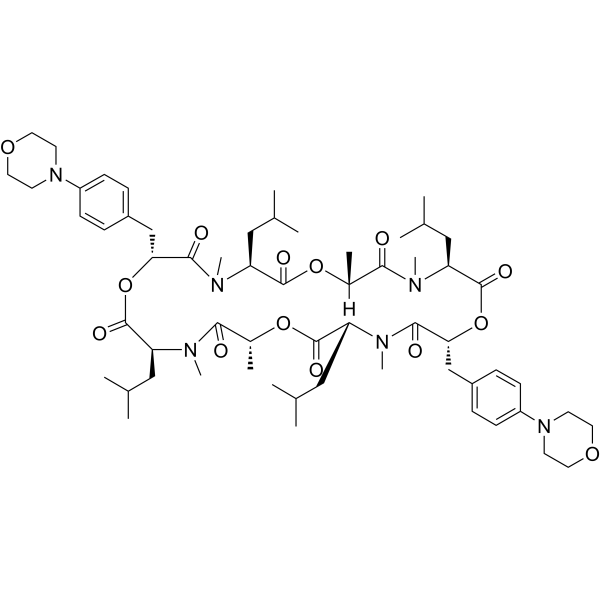| Synonyms: |
Cyclo[(aR)-a-hydroxy-4-(4-morpholinyl)benzenepropanoyl-N-methyl-L-leucyl-(2R)-2-hydroxypropanoyl-N-methyl-L-leucyl-(aR)-a-hydroxy-4-(4-morpholinyl)benzenepropanoyl-N-methyl-L-leucyl-(2R)-2-hydroxypropanoyl-N-methyl-L-leucyl];(3S,6R,9S,12R,15S,18R,21S,24R)-4,6,10,16,18,22-hexamethyl-3,9,15,21-tetrakis(2-methylpropyl)-12,24-bis[(4-morpholin-4-ylphenyl)methyl]-1,7,13,19-tetraoxa-4,10,16,22-tetrazacyclotetracosane-2,5,8,11,14;PF 1022-221;Cyclo((R)-lactoyl-N-methyl-L-leucyl-(R)-3-(p-morpholinophenyl)lactoyl-N-methyl-L-leucyl-(R)-lactoyl-N-methyl-L-leucyl-(R)-3-(p-morpholinophenyl)lactoyl-N-methyl-L-leucyl);Emodepside;Emodepside [INN];UNII-YZ647Y5GC9;Cyclo(.alpha.R)-.alpha.-hydroxy-4-(4-morpholinyl)benzeneprop;Cyclo(.alpha.R)-.alpha.-hydroxy-4-(4-morpholinyl)benzenepropanoyl-N-methyl-L-leucyl-(2R)-2-hydroxypropanoyl-N-methyl-L-leucyl-(.alpha.R)-.alpha.-hydroxy-4-(4-morpholinyl)benzenepropanoyl-N-methyl-L-leucyl-(2R)-2-hydroxypropanoyl-N-methyl-L-leucyl;Cyclo(.alpha.R)-.alpha.-hydroxy-4-(4-morpholinyl)benzenepropanoyl-N-methyl-L-leucyl-(2R)-2-hydroxypropanoyl-N-methyl-L-leucyl-(.alpha.R)-.alpha.-hydroxy-4-(4-morpholinyl)benzenepropanoyl-N-methyl-L-le;YZ647Y5GC9;BA;155030-63-0;DTXCID6088290;(3S,6R,9S,12R,15S,18R,21S,24R)-3,9,15,21-tetraisobutyl-4,6,10,16,18,22-hexamethyl-12,24-bis(4-morpholinobenzyl)-1,7,13,19-tetraoxa-4,10,16,22-tetraazacyclotetracosan-2,5,8,11,14,17,20,23-octaone;EMODEPSIDE (EMA EPAR VETERINARY);cyclo[(R)-lactoyl-N-methyl-L-leucyl-(R)-3-(p-morpholinophenyl)lactoyl-N-methyl-L-leucyl-(R)-lactoyl-N-methyl-L-leucyl-(R)-3-(p-morpholinophenyl)lactoyl-N-methyl-L-leucyl];cyclo {D-lactoyl-N-methyl-L-leucyl-3-[4-(4-morpholinyl)phenyl]-D-lactoyl-N-methyl-L-leucyl-D-lactoyl-N-methyl-L-leucyl-3-[4-(4-morpholinyl)phenyl]-D-lactoyl-N-methyl-L-leucyl};emodepsidum;CHEMBL2104404;AKOS040759291;CYCLO((.ALPHA.R)-.ALPHA.-HYDROXY-4-(4-MORPHOLINYL)BENZENEPROPANOYL-N-METHYL-L-LEUCYL-(2R)-2-HYDROXYPROPANOYL-N-METHYL-L-LEUCYL-(.ALPHA.R)-.ALPHA.-HYDROXY-4-(4-MORPHOLINYL)BENZENEPROPANOYL-N-METHYL-L-LEUCYL-(2R)-2-HYDROXYPROPANOYL-N-METHYL-L-LEUCYL);PROCOX COMPONENT EMODEPSIDE;(3S,6R,9S,12R,15S,18R,21S,24R)-3,9,15,21-tetraisobutyl-4,6,10,16,18,22-hexamethyl-12,24-bis(4-(morpholin-4-yl)benzyl)-1,7,13,19-tetraoxa-4,10,16,22-tetraazacyclotetracosane-2,5,8,11,14,17,20,23-octone;E74446;NS00134287;EMODEPSIDE [GREEN BOOK];PF-1022-221;EMODEPSIDE [EMA EPAR VETERINARY];SCHEMBL167580;(3S,6R,9S,12R,15S,18R,21S,24R)-4,6,10,16,18,22-hexamethyl-3,9,15,21-tetrakis(2-methylpropyl)-12,24-bis[(4-morpholin-4-ylphenyl)methyl]-1,7,13,19-tetraoxa-4,10,16,22-tetrazacyclotetracosane-2,5,8,11,14,17,20,23-octone;EMODEPSIDE [MI];8I2;BAY 44-4400;emodepsida;4,6,10,16,18,22-Hexamethyl-3,9,15,21-tetrakis(2-methylpropyl)-12,24-bis[(4-morpholin-4-ylphenyl)methyl]-1,7,13,19-tetraoxa-4,10,16,22-tetrazacyclotetracosane-2,5,8,11,14,17,20,23-octone;DB11403;cyclo [D-2-hydroxypropanoyl-N-... |

 DC Chemicals' products qualify for U.S. tariff exemptions. We guarantee no price increases due to customs duties and maintain stable supply, continuing to deliver reliable research solutions to our American clients.
DC Chemicals' products qualify for U.S. tariff exemptions. We guarantee no price increases due to customs duties and maintain stable supply, continuing to deliver reliable research solutions to our American clients.





















